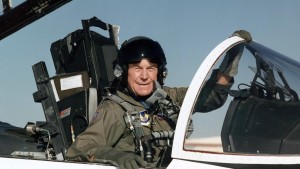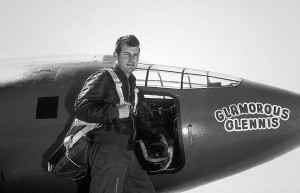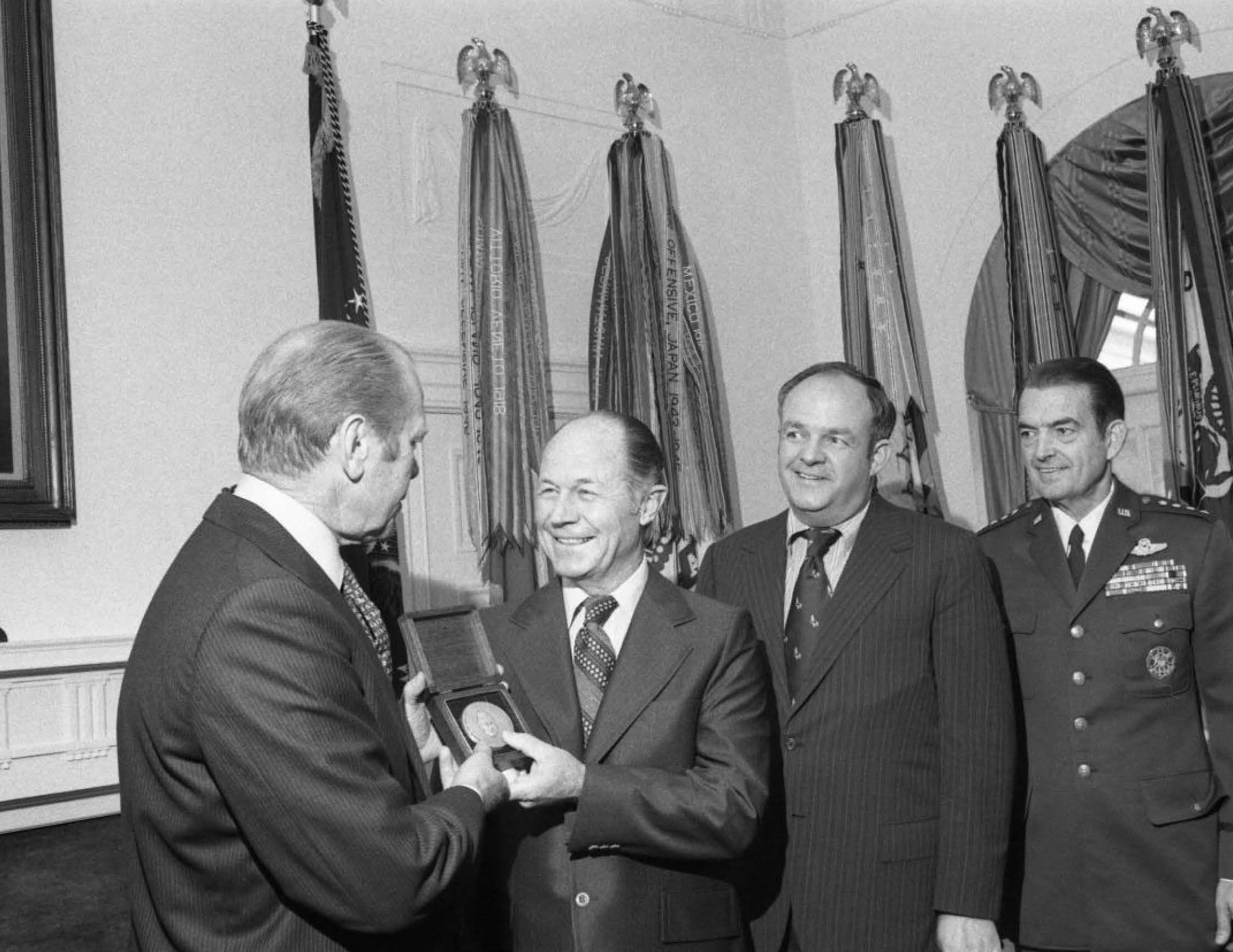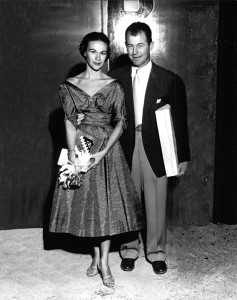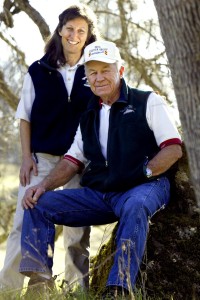General Chuck Yeager – American Hero
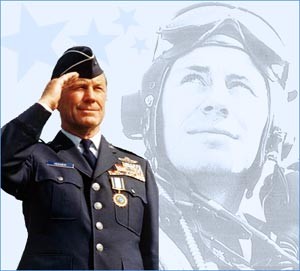
General Chuck Yeager in 1975 age 52 at his United States Air Force retirement. Background- Flight Officer Yeager age 20 during World War II.
General Yeager is one of the greatest aviators that ever lived. His commitment to service, duty, love of his country, his flag are evident in all that he did during active duty and beyond. He was and continues to be a great inspiration and role model.
General Yeager often said he was born so far up a holler, they had to pipe daylight in. He was born in 1923, in Myra, W.Va. and graduated from Hamlin High School. Much later, when they erected a statue of General Yeager in front of the High school, General Yeager quipped; there wasn’t a pigeon in town till they put up that statue.
His first experience with the military was as a teen at the Citizens at Fort Benjamin’s Citizen’s Military Training Camp (CMTC); Indianapolis Indiana, in 1939 and 1940.
He enlisted in the Army Air Corps in September 1941 & was accepted for pilot training under the flying sergeant program in July 1942, and after throwing up all over his airplane the first few times he flew, received his pilot wings and appointment as a flight officer in March 1943 at Luke Field, Ariz.
During World War 11, with excellent eyesight and hand eye coordination, General Yeager distinguished himself in aerial combat over France and Germany during the years 1943-1945 by shooting down 13 enemy aircraft. On March 5, 1944, he was shot down over German-occupied France but escaped capture when the French Underground hid him. After air drops, he educated the Maquis on how to use the plastique explosives. Just after D-Day, the bombs then Flight Officer Yeager made for the Maquis helped blow up the bridges in the south of France where the main telephone lines and boats passed through. The Germans in the south did not hear about D-Day in the north for several weeks so were unable to supply reinforcements.
The Maquis helped Flight Officer Yeager get to the foothills of the Pyrenees to escape the Germans. F/O Yeager carried a wounded airman over these mountains to get to neutral Spain.
When he returned to England, Yeager was ordered to go home. He refused and fought this all the way to General Eisenhower, the Supreme Allied Commander during World War II, who said, “I don’t normally see guys like you, but I am curious; I’ve got people shooting themselves in the foot to go home, what is the matter with you?”
General Yeager said, “I haven’t done my job.”
Ultimately, Gen Yeager, after D-Day, was allowed back on combat, became an ace in a day, and shot down one of Germany’s first jets from his P-51, a prop plane.
A World War II hero, he could have retired then, but he was just getting started.
He returned to the United States in February 1945, married Glennis Yeager in Hamlin, WV. In July 1945 as an evadee, he got to pick his first choice of bases. He chose Wright Field, Ohio, because it was closest to his home in West Virginia. He was a maintenance officer who also flew every aircraft to make sure the maintenance was good. Col Al Boyd noticed and selected Yeager as pilot of the Bell X-1, at Edwards Air Force Base, Calif., where Yeager served from October 1947 to September 1954.
History is not always written quietly. Sometimes it requires a sonic boom.
And that’s what General Yeager did when he made world history on Oct. 14, 1947 and became the first man to fly faster than the speed of sound. The two most significant aviation break throughs – the Wrights first powered flight and Yeager’s breaking the sound barrier.
Rather than retire and make millions in the civilian world based on his accomplishments to date, General Yeager remained in the Air Force. Service. Duty.
During his nine-year assignment as the nation’s leading test pilot, he also became the first man to fly more than twice the speed of sound in level flight, flying the Bell X-IA on Dec. 12, 1953.
During those nine years, he escorted many test pilots who gave their all home. His commanding officer, General Al Boyd, insisted the survivors do so.
Captain Yeager never lost a pilot for whom he flew chase. Often, Yeager had to think fast and he had no problem appearing in trouble to save a life. An X-4 test pilot was showing signs of hypoxia but refused to descend, becoming belligerent (more signs of hypoxia). Captain Yeager exclaimed, “I’ve had a flame out. Got me a real emergency. Follow me down.” That the belligerent pilot could do. When they got to lower altitude, the pilot wanted to adjust his mask and return to higher altitude. Capt. Yeager said, “No way.”
He returned to Europe in October 1954 and became commander of the 417th Fighter Squadron at Hahn Air Base, Germany, in May 1955 and Toul-Rosieres Air Base, France, in April 1956.
In 1954, while in Germany, he started the German American Glider Club fostering great relationships with Germany.
In September 1957, he was assigned to the 413th Fighter Wing at George Air Force Base, Calif., and in April 1958 became commander of the 1st Fighter Squadron. From April to November 1958 he went with the 1st Tactical Fighter Squadron to Moron Air Base, Spain and then returned to George Air Force Base
General Yeager graduated from the Air War College, Maxwell Air Force Base, Ala., in June 1961 and became commandant of the Aerospace Research Pilot School, where all military astronauts were trained, in July 1962.
In July 1966, after President Johnson took the race for space away from the Air Force, General Yeager left ARPS and assumed command of the 405th Fighter Wing at Clark Air Base, Republic of the Philippines. While commander of the 405th Fighter Wing he flew 127 missions in South Vietnam.
General Yeager assumed command of the 4th Tactical Fighter Wing at Seymour Johnson Air Force Base, N.C., in February 1968 and went with the wing to Korea during the Pueblo crisis. In 1969, he was promoted brigadier general, and in July became vice commander, Seventeenth Air Force, with headquarters at Ramstein Air Base, Germany.
In January 1971 General Yeager assumed duties as United States defense representative to Pakistan where the pilots still highly respect him.
In order to keep flying even as a General because he was Director of Aerospace Safety at Norton Air Force Base, Calif., in 1973. There, General Yeager changed the Air Force policy from a primary and secondary cause accident to an all cause accident. Before, the primary cause would be fixed but not the secondary cause, which then because a primary cause in the next accident. With all cause, all causes were fixed. General Yeager permeated the civilian and commercial world thereby saving millions of lives.
General Yeager retired in March 1975.
His military decorations and awards include the Distinguished Service Medal, Silver Star with oak leaf cluster, Legion of Merit with oak leaf cluster, Distinguished Flying Cross with two oak leaf clusters, Bronze Star Medal with “V” device, Air Medal with 10 oak leaf clusters, Air Force Commendation Medal, Purple Heart, Distinguished Unit Citation Emblem with oak leaf cluster and the Air Force Outstanding Unit Award Ribbon, He was a command pilot and has flown more than 12,000 hours in 361 different makes and models of military aircraft.
President Truman awarded General Yeager the MacKay Trophy in 1948, the Collier Trophy in 1948, (for breaking the sound barrier) and the Harmon International Trophy in 1954 (for exceeding MACH 2)
General Yeager was awarded honorary Doctor of Science degrees from West Virginia University, in 1948, among others.
After his retirement, General Yeager consulted the Air Force for a dollar a year. The Air Force requested his time and name continuously for public relations, inspiration, advice and recruitment.
President Reagan assigned General Yeager to the Rogers Commission for the Challenger Disaster.
For many years, from approximately 1978-1997, General Yeager opened the Edwards AFB, CA air show with a sonic boom. He returned several times to repeat this: 2000, 2002-2007, 2010-2011, and to Nellis AFB in 2012. While at each of these, he gave talks, visited with pilots, maintainers, and other employees of the bases.
From 1980-2000; General Yeager returned to Maxwell Air Force Base Air Command and Staff College for its annual seminar to speak to and visit with students.
While at the seminars for Maxwell, starting in 1994, he flew Young Eagles getting kids exposed to and interested in aviation. He was Chairman of the program whose goal was to get 1 million kids to fly by December 17, 2003, the 100th anniversary of the Wright Brothers first powered flight. Indeed, he got 1.2 million, flying over 500 himself.
General Yeager created the Marshall University Yeager Scholars in 1987; a premiere four-year full scholarship elevating students from the Appalachians.
He attended countless Dining Ins, Dining Outs, and gave countless speeches on air bases around the world. At the Air Force Academy Leadership program, many of the veterans who attended were renewed in hope for the United States of America and for themselves. He attended programs with the Tuskegee Airmen and various other members of the military.
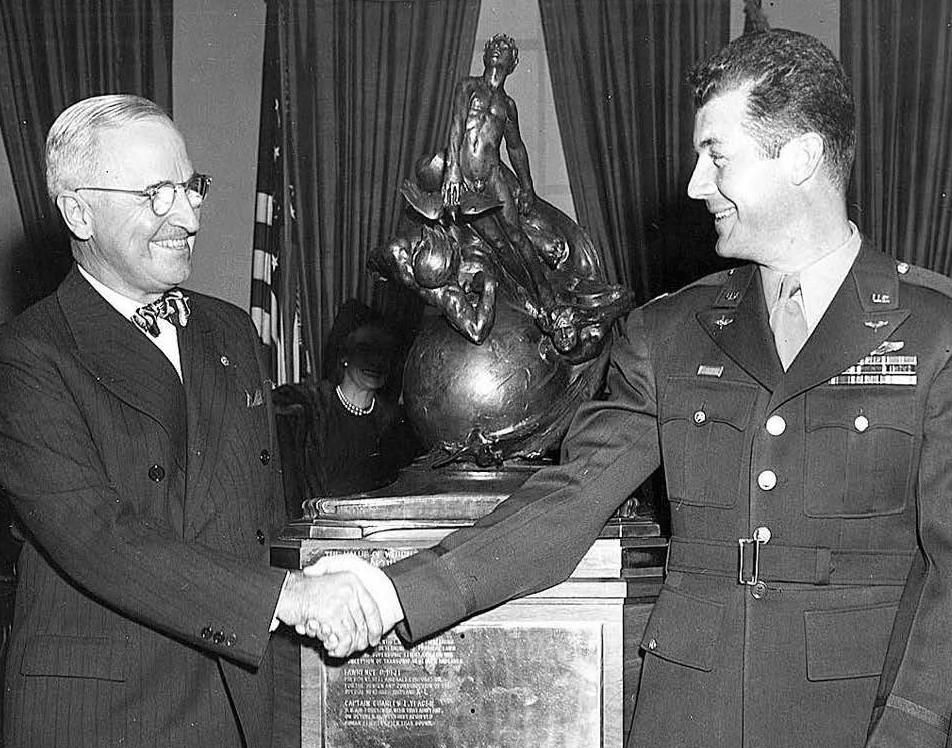
December 17, 1948, Washington, D.C.: President Harry Truman awards the Collier Air Trophy, commonly rated aviation’s highest honor, to Captain Chuck Yeager.
1976: By special act of Congress (making it one of the rare true Congressional Medals of Honor), General Yeager was awarded the Special Silver Congressional Medal of Honor. the Special Congressional Silver Medal of Honor, essentially a peacetime Medal of Honor; “equivalent to a noncombat Medal of Honor…for contributing immeasurably to aerospace science by risking his life piloting the X-1 research airplane faster than the speed of sound on October 14, 1947.”
38th President of the United States Gerald R. Ford, in presenting this award, said: “Brigadier Charles E. Yeager, United States Air Force (Retired), displayed conspicuous gallantry and total disregard for his personal safety on October 14, 1947, as pilot of the XS-1 research aircraft. On that date, the then Captain Yeager advanced aerospace science a quantum step beyond the first half-century of powered flight by proving that an aircraft could be flown at supersonic speeds. In that brief 14 minute flight, General Yeager dispelled for all time the mythical ‘sound barrier’ and set the stage for unprecedented aviation advancement. Through his selfless dedication to duty and his heroic challenge of the unknown, General Yeager performed inestimable service to his country far above and beyond the call of duty and brought great credit upon himself and the United States of America.”
40th President of the United States Ronald Reagan gave General Chuck Yeager the highest civilian award, the Presidential Medal of Freedom : “A hero in war & peace, Charles Yeager has served his country w/ dedication & courage beyond ordinary measure. On October 14, 1947, in a rocket plane which he named “Glamorous Glennis’
2003 France awarded General Yeager the Legion of Honor as an Officer, the highest award for a non-citizen.
Congress also awarded General Yeager, as a World War II Fighter Ace, the Gold Congressional Medal of Honor.
41st President of the United States George H.W. Bush: “If I had to sum up General Chuck Yeager in one word, it would be ‘service’.”
43rd President of the United States George W. Bush: “General Chuck Yeager is one of the greatest fighter pilots ever. Thank you for being a pioneer.”

Vice President Mike Pence delivers remarks during the “Celebration of Life” service for Retired Brig. Gen. Chuck Yeager at the Charleston Coliseum & Convention Center in Charleston, West Virginia, Jan. 15, 2021. Yeager was an Air Force flying ace and test pilot who in 1947 became the first in history confirmed to have exceeded the speed of sound in level flight. (U.S. Air Force photo by Wesley Farnsworth)
48th Vice President of the United States Mike Pence at the January 15, 2021 memorial service for General Chuck Yeager: “The truth is Chuck Yeager has been an inspiration to every American pilot and will be throughout time. Chuck Yeager was a commander of enormous courage and Chuck Yeager was a great man who dedicated his life to the service of this country. America will cherish always the memory and the service and the example of Chuck Yeager.”
Speaker of the House Newt Gingrich: “Chuck Yeager should be an inspiration to younger Americans. He is owed a lifetime of gratitude.”
There were many many other awards – the above is just a sample.
In 1966, Yeager was inducted into the International Air & Space Hall of Fame. He was inducted into the International Space Hall of Fame in 1981 and the Aerospace Walk of Honor’s 1990 inaugural class. In 2009, Yeager was inducted into the California Hall of Fame.
He was a member of the Society of Experimental Pilots and the Explorers’ Club, the American Fighter Aces, and a board member of The Wings of Hope and Pacific Aviation Museum in Hawaii, as well as Air Force Flight Test Foundation.
General Yeager’s great influence extended to civilian pilots speaking to passengers trying to imitate General Yeager’s West Virginian, down home accent.
He has written two books, “Yeager, An Autobiography” and “Press On”, appeared in the movie “The Right Stuff”, a video game called Chuck Yeager’s Air Combat, commercials, and more.
In addition to all his volunteer service for the military after he retired from active duty, he helped raise money for various programs; Young Eagles, Civil Air Patrol, down-syndrome folks, fish habitat, conservation, scholarships for children of Fighter Aces, scholarships for aviation, and much, much more.
Captain Chuck Yeager married Glennis Dickhouse in 1945. She passed in 1990.
General Yeager met Victoria Yeager in 2000 and they were married in 2003
Since Arlington National Cemetery is the repository of American History and General Yeager is one of the best of our military history, we are placing a cenotaph there.
c. GCYI

